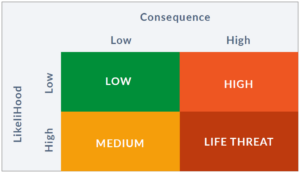Whitepaper: Leading Risk Metrics

In our introductory paper to Safety Assurance Methodology, the different components of how to develop an effective SAM system were highlighted, with the ultimate goal being the achievement of effectively managing risk. As an essential part of determining the “acceptable levels” within an organization, risk metrics must be assessed. In this paper, leading risk metrics will each be presented in greater detail and highlighted to show both the simplicity and the value. While each piece of the puzzle is simple, the collective methodology yields a value that far exceeds the sum of each individual part.
Continue Reading
Fill out the form to continue reading
Tools for Displaying Workplace Safety Inspections and Safety Observations
(Leading Risk Metrics)
In our introductory paper to Safety Assurance Methodology, the different components of how to develop an effective SAM system were highlighted, with the ultimate goal being the achievement of effectively managing risk. As an essential part of determining the “acceptable levels” within an organization, risk metrics must be assessed. In this paper, leading risk metrics will each be presented in greater detail and highlighted to show both the simplicity and the value. While each piece of the puzzle is simple, the collective methodology yields a value that far exceeds the sum of each individual part.
1. Inspections
Measured as: Number of inspections completed
The fundamental building block of this leading indicator pathway is the collection of worksite safety observations through inspections. All other leading indicators described below are predicated on this activity. These inspections can vary from behavior-based safety (BBS) to compliance to equipment inspections. In addition, inspections can be broad and wide- sweeping or targeted and focused on criteria such as specific tasks, hazards, or areas. The focus of this metric is to measure participation. Inspections can serve as a proxy for employee engagement as well as measure how employees perceive the value of the overall inspection program.
As with any program, established criteria is necessary to communicate clear expectations. Having clear goals helps employees to understand their part in the overall vision of the program. The diversity of those conducting inspections should be varied and shared across the team. While full-time safety professionals are expected to do more safety inspections, they should not be the only people doing inspections.
A typical expectation for observers can be broken down by role:
- Safety – Daily inspections
- Front-line supervision – Weekly inspections
- Others – Bi-weekly or Monthly
It is important to establish clear roles and responsibilities of each team member before asking them to participate.
2. Observations
Measured as: Number of unique findings or observations
Inspections are a collection of one or more observations. Observations are specific instances of a behavior or condition. An example would be a worker wearing the proper safety glasses or the condition of an electrical cord. In addition, observations can be determined to be safe or at-risk (e.g., wearing the proper safety glasses or NOT wearing the proper safety glasses). As a best practice, each behavior or condition should be counted separately during an inspection.
The importance of monitoring this metric includes consistency in approach of observers, ensuring observers are documenting more than just at-risk findings, and allows for drill-down into which items on the checklist were or were not observed. For example, if ten workers were present in a work area and safety glasses were being observed, each worker’s behavior can be documented separately. This methodology aids in measuring the scope of the inspection, the number of unique instances observed, and the ratio of safe versus at-risk findings overall.
The importance of monitoring this metric includes consistency in approach of observers, ensuring observers are documenting more than just at-risk findings, and allows for drill-down into which items on the checklist were or were not observed.
3. Safe Observations
Measured as: Number of unique safe findings or observations
Safe observations provide a significant number of advantages to the overall safety inspection process.
- Positive feedback can be used when safe observations are collected and used. The idea is to coach to improve and move away from the safety “enforcer”
mentality of punishing workers for safety violations. - Measuring failures only is inherently flawed. Specifically, if only at-risk findings are collected and safe findings are not, it paints a very incomplete picture. Absence of unsafe observations could just as easily be attributed to not looking at them at all as opposed to safe work measurement! Safe observations show proof that something did take place and become a historical marker of what was observed (for instance, an item on the checklist), what location the observation took place, and the condition in which it was found.
- Provided a proper sampling method is employed during observation collection and reflects a representative reflection of the work and the risks, then collecting safe and at-risk observations can effectively provide a ratio of safe vs. at-risk. For example, would you be more concerned about a ratio of 5% at-risk or 50% at-risk?
- By counting a representative amount of safety observations and not just checking a single box for the entire inspection, the context of findings can be
determined as well. For example, two unsafe observations for failure to use safety glasses are found. If only a few workers observed, then this is significant. If over 200 other workers were wearing safety glasses, then the gravity of the findings is diminished, allowing focus on more severe findings. - Only through safe observations can improvement be measured. For example, if a high number of at-risk observations for a certain hazard are found and an action plan was implemented to address it, how would you know if there was improvement? Bear in mind, an absence of at-risk findings could also mean nobody is even looking. An improved ratio of safe vs. unsafe should support an improvement in the specific safety process that was of concern.
4. Percent Safe
Measured as: Dividing the total number of safe observations by the total number of all observations.
Percent safe, a derivative metric of safe observations, can provide some key benefits but only if properly understood. The following provides more information on how to view and respond to the percent safe metric.
- Risk Indicator – When looking at the big picture, it becomes clear that percent safe in and of itself is a poor risk indicator, especially at the single inspection level due to the small sample size. In addition, an inspection is a snapshot in time, often combining dissimilar tasks, hazards, and activities (e.g., fall protection plus housekeeping plus PPE.) It is very easy to overreact to the number and make rash statements or decisions which can be damaging to any progress made. Percent safe does what it is designed to do provide a ratio of safe vs. at-risk findings collected and documented. It is understanding the metric, its limitations, and the positive actions taken in response to the findings that makes it effective.
- Long-term trending – When a statistically significant number of observations are collected with the same or similar theme (e.g., fall protection category,) percent safe can provide a good metric on the efficacy of the safety process. It is a good “vectoring” metric—showing current direction and trajectory.
- Measure progress – The percent safe metric can also be used to measure systemic progress. When a process is deemed “out of control” or “in need of
improvement,” then percent safe is a good metric to determine if positive strides are being made. More safe observations should be seen, and fewer unsafe observations should be discovered, if action is taken to apply controls to the process. The key again is that the data must be closely grouped within a common theme and evaluated for value (e.g., “proper ladder use” or “good condition of electrical cords.”)
5. Frequency of All-Safe Inspections
Measured as: The percentage found when dividing the number of 100% safe inspections by the total number of inspections.
Inspections consist of observations that can be either safe or at-risk. While most observations are safe, the finding of at-risk observations should be viewed as a positive experience. The documentation of at-risk findings grants transparency and visibility into risk in the field, allowing proactive action to be taken to prevent injuries.
While at first it may seem counterintuitive, a high number of inspections with no at-risk findings is undesired and correlates to higher risk of having injuries.
Intuitively it may seem that as worksites improve their safety performance, the number of at-risk findings will diminish. However, the proportion of at-risk findings remains steady as organizations strive to improve their overall safety performance. If most inspections are retuning 100% safe information, there may be other factors at play.
Questions to ask in that circumstance include:
- Are observers trained to identify hazards?
- Are the checklists and questions being utilized the right ones for the risks?
- Does the company culture positively support the reporting of at-risk findings?
- Does feedback after submitting at-risk findings support or hinder future
reporting?
While it is understood and expected to conduct focused inspections that yield no at-risk findings, it should be the exception and not the norm. Interestingly, observers generally either collect at-risk findings or they don’t. It is not about the metric, however. The conversation on high frequency all-safe inspections should focus on why.
6. At-Risk Observations
Measured as: Number of at-risk findings or observations.
Observations can serve to identify work practices and conditions that pose a risk of injury. Organizations can then take proactive steps to prevent injuries. In practice, the observer is comparing expectations of work, as defined in a health and safety plan, to work as performed. The gaps, as identified and documented as at-risk findings, are opportunities to evaluate and improve as necessary. It is hard to manage risk if it is unknown where the risk resides. Honesty in reporting any deviation from the plan, such as an at-risk finding, is imperative. As humans, especially when judged or perceived to be judged by outcomes, we tend to downplay risks and assure those around us that everything is perfectly fine.
If blame can be removed so that fear is driven out, it can lead to continual learning and improvement. Additionally, the more detailed the finding, the more learning opportunity it affords. Including pertinent information in a comment section can vastly improve the value of each finding submitted.
7. Severity
The degree of risk associated with an at-risk observation.
A risk matrix can be employed by observers to classify findings according to their potential level of harm. Low and medium/moderate findings are linked to low
consequence potential. PPE, housekeeping items, and minor administrative items are examples of these classifications. High and life-threatening observation
findings are related to high consequence potential. Examples include falls from heights, electrical exposures, confined spaces, struck by and caught in/between
hazards, and work with hazardous materials.
On average, about five times as many low and moderate severity unsafe observation findings are recorded compared to high or life-threatening findings. This demonstrates the proclivity to focus on routine, low consequence activities over activities that typically lead to significant injuries and fatalities.
On average 50% of all at-risk findings are classified as medium risk or higher.
Whereas, only 10% of all at-risk findings are classified as high or life-threatening.
Metrics Summary
These metrics are relatively universal across industries. While the particular hazards and therefore the approach may vary, the resultant metrics are often compared quite easily across disparate industries, as is currently done with injury rates. If enough organizations collect this information and share the metrics (not necessarily the precise findings), then benchmarking of leading indicators can aid in guiding better observational approaches and improved data use plans for index collection.
The ones discussed here are not the ONLY leading indicators available. However, they are the most utilized across diverse enterprises. Therefore, they are the most likely to be collected and shared across industries for benchmarking.
While it is not the adoption or the gathering of leading indicators that leads to improvement, but the action taken based on the information that determines success, understanding how these tools are used is still an important step in that direction. The process should be carried out not as much in the analysis of the metrics, but more in the conversations and feedback they elicit. When driving continuous improvement, the frequency and quality of the feedback generated from the findings determines the extent of success.
Your Complete, Cloud-Based Safety Solution
An online, integrated platform to protect your team,
reduce risk, and stay compliant




